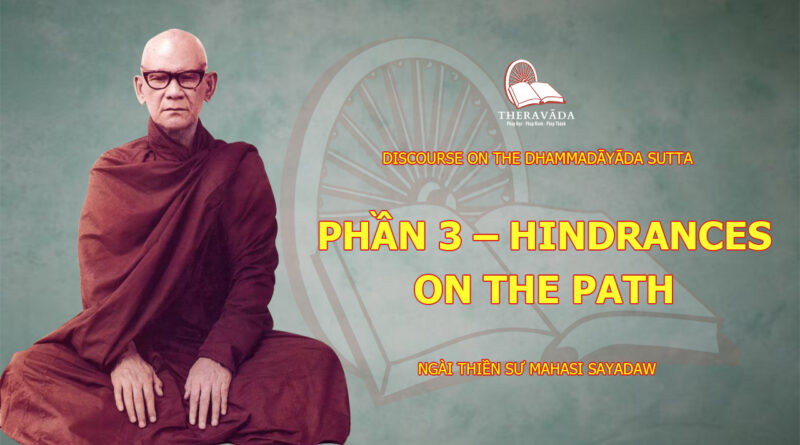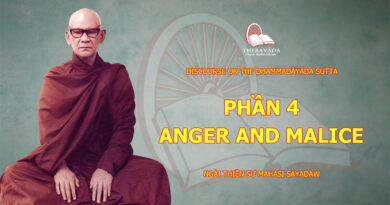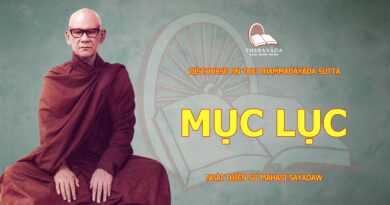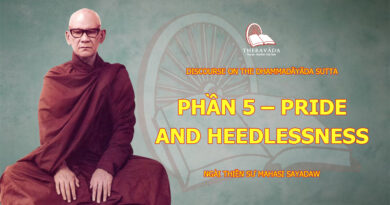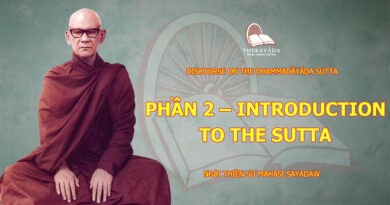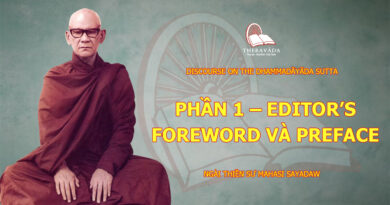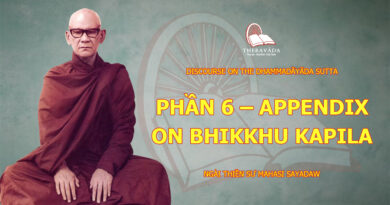Phần 3 – Hindrances on the Path
– Hindrances on the Path
– Greed and Aversion
– Concentration Is Essential to Gain Insight
– The Practice of the Middle Way
– Practice for Buddhahood
– Right Effort
– Right Mindfulness
– Right Concentration
Hindrances on the Path
According to Venerable Sāriputta, some disciples of the Buddha lead the way to degeneration. There are five causes of degeneration called hindrances (nīvaraṇa) to the attainment of concentration and wisdom. These are sensual desire, ill-will, laziness, restlessness, and doubt. Here laziness (thīnamiddha) means reluctance to listen to or practise the Dhamma and getting bored or dejected during meditation practice. Restlessness (kukkucca) is worry or anxiety over one’s past mistakes and doubt (vicikicchā) refers to doubt about the Buddha, Dhamma, and Saṅgha, or about the way to the attainment of the path, its fruition, and nibbāna.
If a man leads an immoral life, giving himself up to drinking, gambling, and other vices, his children will follow suit when they grow up. Likewise, the elderly monks who yield to hindrances and idle away their time are bound to have a demoralizing effect on younger members of the Saṅgha. In fact, they lead the way to degeneration. They are like a person who puts down the burden that he is supposed to carry, because they have abandoned the insight practice that leads to the extinction of defilements. Some give it up after practising it for some time and there are even some monks who criticise and discourage those who practise insight meditation. So according to the Dhammadāyāda Sutta, such errant monks are blameworthy on three counts. They do not practise detachment that is so much cherished by the Buddha. They make no effort to remove the defilements. What with their excessive craving for material goods, they do not practise insight meditation for the extinction of defilements. To avoid such criticism by good people, the monks should practise detachment that the Buddha enjoins on them. At the very least they should practise physical detachment by living in solitude. They should sincerely practise morality and concentration to overcome the defilements. They should strive at least for the attainment of Stream-winning that ensures freedom from ego-belief and doubt.
The teaching of the Buddha as regards the evil consequences of moral laxity in the Saṅgha applies to all bhikkhus regardless of their age or spiritual status. The Buddha specifically mentioned the senior monks, the monks of medium standing, and the junior monks who are to be censured for their moral deficiency. Here the senior monks (thera) have spent ten or more years in the order, the monks of medium standing (majjhima) have spent over five years, while the junior monks (navaka) are those who have less than five year’s standing in the Saṅgha. So the discourse concerns all monks, and every monk deserves criticism if he fails to emulate the Buddha and fails to live up to his teaching.
On the other hand, a monk who practises detachment is worthy of praise because he is following the example of the Buddha; he has overcome defilements and finally he does not care for his material welfare and is therefore not negligent in the practice of the Dhamma.
In commenting on the Buddha’s discourse Venerable Sāriputta uses the word “praiseworthy” (pasaṃsa), to inspire the monks, but what matters most is practice of the Buddha’s teaching which makes one a worthy heir of the Dhamma. It is the heritage of the Dhamma that can ensure permanent freedom from suffering and the dangers of the lower realms. It is this Dhamma heritage that Venerable Sāriputta has in mind when he refers to the praiseworthiness of well-disciplined monks for the inspiration and edification of his listeners.
Greed and Aversion
Then Venerable Sāriputta goes on to describe greed and aversion as the first two defilements that should be removed. Lobha may be translated as desire, craving, delight, lust, clinging, attachment, greed and so forth. Evil-doing is usually motivated by greed. People suffer because they seek the object of their desire, they have to please those whom they love. Greed fuels evil and because of its unwholesome nature it leads to suffering in hell. Moreover, it causes repeated rebirths together with the attendant old age. sickness, death, and other suffering.
Dosa means aversion, anger, ill-will, the aggressive and destructive impulse, etc. Seeing or hearing anything that we dislike makes us angry and unhappy. We yield to anger and kill or mistreat others, making unwholesome kamma that leads to the lower realms. If reborn in the human world one has to pay for one’s past acts motivated by ill-will by brevity of life, sickliness, and other negative results.
There is a way to overcome greed and aversion. It is the middle way between the two extremes of over-indulgence in sensual pleasures and asceticism. Some people spend all their time gratifying their sensual desires, and there are some who practise self-mortification that does not help to develop concentration and tranquillity. The Buddha’s way avoids the two extremes. This middle way is not to be found in the non-Buddhist systems of thought. It is the Noble Eightfold Path comprising right view, right thought, right action, right speech, right livelihood, right effort, right mindfulness, and right concentration. This Path helps develop the eye of wisdom and insight-knowledge. The eye of wisdom is so called because it enables us to see clearly. It does not differ essentially from insight-knowledge. In the practice of the eightfold path we have to observe the mental and physical processes or the five aggregates of attachment (upādānakkhandhā) that takes place ceaselessly within us. At every moment of seeing, hearing, etc., we should note the psycho-physical phenomena. Such moment-to-moment mindfulness helps to develop a clear insight into the nature of mental and physical phenomena.
In the course of the practice we come to distinguish between mind and matter. When seeing, we recognise the eye and the visible object as material phenomena, and the eye-consciousness and the noting consciousness as mental phenomena. When hearing, we recognise the ear and the sound as material phenomena and the ear-consciousness and the noting consciousness as mental phenomena. When smelling, we recognise the nose and the odour as material phenomena and the nose-consciousness and the noting consciousness as mental phenomena. In tasting, we recognise the tongue and taste as material phenomena and taste-consciousness and noting consciousness as mental phenomena. When touching, we recognise the sensitivity of the physical body and the tactile object as material phenomena and the tactile-consciousness and the noting consciousness as material phenomena. When thinking, we recognise the physical base of the mind as material phenomena and thinking and the noting consciousness as mental phenomena.
As the Satipaṭṭhāna Sutta says, “Gacchanto va gacchāmī’ti pajānāti…” when the meditator notes standing, sitting, lying, bending, stretching, etc., he distinguishes between material phenomena and mental phenomena in the same way. Thus when he notes walking, putting forward the right food, putting it down, etc., he is aware of the distinction between stiffness, movement, and the noting consciousness. The same may be said of the abdominal rising and falling and other bodily movements that are noted. This is insight knowledge of the distinction between mind and matter that leaves no room for a living entity. This analytical knowledge of body and mind (nāmarūpaparicchedañāṇa) and Purification of view (diṭṭhi-visuddhi) arise from experience and have nothing to do with logic or speculation. It accords with one of the attributes of the Dhamma, namely one has to realise the Dhamma by oneself (sandiṭṭhiko), and with the Satipaṭṭhāna Sutta, which stresses the need for practice and personal realisation.
There are some people who criticise the Satipaṭṭhāna method of meditation. They say that is not necessary to note ordinary activities such as walking, standing, etc., that are so familiar to us in our everyday life and that these exercises will not lead to extraordinary insight-knowledge. This criticism is due to lack of experience in the practice of insight meditation according to Satipaṭṭhāna Sutta.
We breathe in and out every day, but few people will question the value of the breathing exercise (ānāpāna) in mind-training. Non-Buddhist holy men in India practise it too, but their goal is just to attain tranquillity (samādhi). It does not follow, however, that the practice of in-and-out breathing cannot lead to insight or path knowledge. Likewise, we should not assume that the practice of noting one’s bodily movements has little to do with the development of mindfulness, concentration, and insight-knowledge. For those who do physical exercises are intent on improving their health whereas those who fix their mind on bodily movements hope to develop mindfulness, concentration, and other higher states of consciousness.
Moreover, there are other reasons why we should not belittle the practice of noting what is familiar to us. Thus in the practice of kasiṇa (external devices in mind-training) we use ordinary objects such as earth, water, colour, etc., but it is a mistake to think that these devices do not lead to the attainment of absorption (jhāna). Some meditation exercises involve contemplation of the organs of the body such as hair, teeth, finger-nails, or excreta, but it would be naïve to lump them together with the daily activities of grave-diggers or sewage workers whose daily experience does not mean anything in terms of spiritual uplift.
Criticism of the insight practice that involves noting the familiar is incompatible with the Buddha’s teaching about insight meditation. To note standing, sitting, and so forth according to the Satipaṭṭhāna method is a far cry from ordinary awareness of physical movements. For ordinary awareness does not call into play mindfulness, concentration, and other higher mental faculties. On the contrary, it is dominated by ignorance which gives rise to illusions of permanence, pleasure, and ego-entity.
Hence ordinary awareness is closely bound up with greed, aversion, and other defilements whilst Satipaṭṭhāna meditation is designed to replace ordinary, illusion-ridden awareness with right mindfulness and right concentration. However, before a meditator has developed concentration, he or she cannot achieve the goal. In the lifetime of the Buddha there were some people with special potential (pāramī) who developed insight and attained the noble path and its fruition in a short space of time. Nowadays there are only a few cases of meditators who attained concentration and insight in a few days.
Concentration Is Essential to Gain Insight
The importance of concentration as an essential prerequisite for insight is borne out by the Buddha’s teaching: “Samādhiṃ bhikkhave bhāvetha samāhito bhikkhave bhikkhu yathābhutaṃ pajānāti —Monks, you should cultivate concentration. The monk who has attained concentration sees things as they really are (yathābhutaṃ).”
To see a thing as it really is to realise the impermanence of the eye-organ, the visible object, the eye-consciousness and the pleasant or the unpleasant feeling that arises at the sight of an object. The same may be said of the insight into reality at the moment of hearing, touching, and so forth. The insight occurs only when concentration is well developed. In other words, it is only concentration that leads to insight into reality, which is empirical knowledge that has nothing to do with using logic or the intellect.
Insight into impermanence is genuine insight, but it does not arise as soon as the meditator develops concentration. When the mind is free from hindrances, it achieves purity. With Purification of Mind, the meditator discriminates between body and mind at every moment of noting. This discriminating consciousness emerges not at the beginning of the practice but only when concentration gains momentum. Then the meditator knows that there are only body and mind, mind being consciousness and body being the object of the consciousness. He or she knows that there no ego, no living being besides body and mind. He or she thus attains the Purification of View (diṭṭhi-visuddhi).
Then as the meditator notes walking, bending, etc., he or she knows the desire to walk as the cause of walking. Similarly, it is the desire to bend the arm that causes it to bend and there is no ego that makes the arm bend. We see because there are the eyes to see and the object to be seen. There is no ego that causes us to see. Thus we distinguish between cause and effect. This is called Knowledge by Discerning Conditionality (paccayapariggahañāṇa). This insight develops into Purification by Overcoming Doubt (kaṅkhāvitaraṇa-visuddhi) when the meditator realises that the future as well as the past is also governed by cause and effect. It is the insight that helps to remove doubt about one’s existence in the past or future. This and other insights occur when the meditator develops the eightfold path by noting the mental and physical process from moment-to-moment. This special illumination is referred to in the Buddha’s teaching as giving rise to the eye of wisdom (cakkhukaraṇī).
The experience is like that of a blind man who has recovered his sight because of good medicine. Formerly the meditator regarded the ego as the agent of seeing, hearing, etc. He or she might have heard of the teaching which denies ego and insists on the body and mind or cause and effect as the only realities in the universe.
With the further development of concentration the eye of wisdom brings the meditator to higher stage of insight. As he or she goes on noting the mental and physical process, he or she becomes aware of the arising and passing away of the object of mindfulness. This knowledge of things as they really are (yathābhūta-ñāṇa) means insight into the arising and passing away of all phenomena. At first the awareness is diffuse, being restricted to the continuity of the same kind of body and mind. Then the meditator realises that everything is in a flux, that there is nothing permanent, that all is suffering and devoid of ego-entity. This is Knowledge of Comprehension (sammasana-ñāṇa).
Then as concentration develops further, the meditator gains insight into the dissolution of phenomena in taking a step forward, in bending the hand, etc. Within one rising and one falling he or she notes the phenomena vanishing piece by piece. When he or she hears something, hearing and vanishing are known as distinct phenomena. He or she does not know the meaning of the sound because there is no link between two consecutive sounds. So too when seeing something the meditator notes only seeing and vanishing. This is Knowledge of Arising and Passing Away (udayabbaya-ñāṇa). At this stage the meditator sees lights and experiences ecstasy. He or she feels very light and comfortable. The mind is very keen and alert so that there is nothing that escapes his or her attention.
Then when the meditator progresses to Knowledge of Dissolution (bhaṅga-ñāṇa) and notes walking, lifting the foot, and putting it down, the appearance of the foot or that of the body becomes dim and only the rigidity and motion remain clear. Even so they are found to vanish one after another as are the other phenomena that the meditator notes in standing, lying, touching, etc. The meditator notes only the vanishing of both the object noted and the noting consciousness. This experience of the meditator affords a deep insight into the impermanence, unsatisfactoriness, and not-self nature of all phenomenal existence and accords with the Buddha’s teaching — “The monk whose mind is concentrated sees things as they really are.” When this eye of wisdom is fully developed, the meditator realises nibbāna with the knowledge born of the noble path and its fruition.
Moreover, the development of the eightfold path through the practice of mindfulness leads to insight, extraordinary knowledge (abhiññāya) and penetrative understanding (sambodhāya). Whenever the meditator knows that everything is impermanent, this knowledge rules out the arising of defilements, and on attaining the noble path the defilements are rooted out. Insight on the eightfold path also leads to nibbāna. With the extinction of defilements, the two cycles of kamma and results in terms of new body and mind also become extinct. This is momentary cessation (tadaṅga nibbāna), which means temporary extinction of suffering inherent in the round of defilements, kamma, and results. When the meditator makes further progress on the noble path, there is the total extinction of defilements, kamma, and body and mind. This is the real nibbāna that stems from abandoning by cutting off defilements (samuccheda pahāna). It is the goal of the Buddhas and the Arahants that guarantees permanent deliverance from suffering.
The Practice of the Middle Way
The way to this permanent peace and freedom or nibbāna is the Noble Eightfold Path. Venerable Sāriputta describes it as the way for the elimination of greed and aversion, the way that leads to the eye of wisdom, extraordinary insight and extinction of defilements. The insight that forms the goal of the path is extraordinary because it makes one aware of the cause and effect relationship between mind and matter, their impermanence, unsatisfactoriness, and not-self.
The middle way is the Noble Eightfold Path, which comprises right view, right thought, right speech, right action, right livelihood, right effort, right mindfulness, and right concentration. This middle way is developed through the contemplation of the mental and physical process whenever it arises at the moment of seeing, hearing, and so forth. Unmindfulness gives rise to craving in the case of a pleasant sense-object and ill-will in the case of an unpleasant sense-object.
With the development of concentration, the meditator becomes aware of the impermanence and conditionality of all phenomena. He or she does not react to them emotionally and so there is no occasion for the arising of craving and ill-will. Every moment of mindfulness involves all the eight factors of the noble path. The effort to focus the attention on all phenomena is right effort. To note walking, standing, etc., is right mindfulness. To fix the mind exactly on the respective sense-object is right concentration. These three factors constitute the concentration aspect of the path.
Again it is right view to know the real nature of the phenomenon, mental or physical, that is noted. In other words, right view is involved when the meditator realises the impermanence of all phenomena, and their lack of any ego-entity that may create the illusion of man or woman, attractiveness or repulsiveness. It is right thought to make the mind intent on the real nature of phenomenal existence. Right view and right thought constitute wisdom. Again these two path factors of wisdom and the three path factors of concentration together form a group called “kāraka maggaṅga,” which means the working path factors. Harmony and co-operation between these path factors is essential for success in insight practice.
Also involved in the practice of insight are the three path factors of morality: right speech, right action, and right livelihood. The meditator already possesses these moral virtues as he or she has undertaken the moral precepts before taking up meditation and at the moment of noting a sense-object, he or she is morally pure because at that time there is no occasion for the emergence of greed or aversion, and so this means freedom from wrong speech, wrong action, and wrong livelihood.
Thus with the gradual weakening of the defilements, the meditator attains the stage of Stream-winning that frees him or her from greed and aversion that are likely to lead him to the lower realms. At the next stage of Once-returning the gross sensual desire and ill-will become feeble, but only the attainment of the next stage of a Non-returner that ensures the total extinction of these defilements. At this stage the meditator takes no delight in sensual pleasure nor does anything make him or her angry. The final stage of Arahantship brings about the complete extinction of attachment to existence (bhavarāga) and all other remaining defilements. So the Buddha points out the eightfold path for the elimination of greed and aversion.
Practice for Buddhahood
Some people believe that it is possible to overcome greed and aversion through proper reflection. Proper reflection may be helpful in some cases, but it is only the noble path knowledge that can root out these two major defilements. So even the Bodhisatta had to contemplate the five aggregates of clinging and develop insight. It was the progress of insight that led to liberation from all defilements and the attainment of Arahantship and Buddhahood. This is borne out by the Mahāpadāna Sutta of the Dīghanikāya which says that the Bodhisatta who was later to become Vipassī Buddha contemplated the five aggregates of attachment just before dawn. Here the aggregates of attachment means the mental and physical process and it is unmindfulness of this process that gives rise to the illusion of permanence, etc., and the consequent attachment to it. The mental and physical process was contemplated by every Bodhisatta just before he attained supreme enlightenment and became a Buddha. So we should bear in mind that every Bodhisatta practised the path of insight, attained the four paths and four fruits, and become a Buddha. The same is true of the disciples of the Buddha. They attained the four paths only after contemplating the aggregates of attachment and developing insight.
At this meditation centre the meditators become aware of the nature of the body and mind while noting the bodily movements, the states of consciousness such as feelings, etc., in accordance with the Satipaṭṭhāna Sutta. With the development of concentration they gain genuine insight. These insights involve the cultivation of right view and other stages of insight, thereby ruling out the arising of greed, aversion, and other defilements.
Those who practise mindfulness in whatever they do, say, feel, or know are the true disciples of the Buddha. They may be monks or lay followers, but they are worthy of praise irrespective of sex or age. They are the heirs of the Dhamma in accordance with the Buddha’s advice. The Noble Eightfold Path that forms the path of insight may be subdivided into three groups: factors of wisdom (paññā maggaṅga), comprising right view and right thought; factors of morality (sīla maggaṅga), comprising right speech, right action and right livelihood; and factors of concentration (samādhi maggaṅga), comprising right effort, right mindfulness, and right concentration.
Right Effort
Right effort (sammappadhāna) is of four kinds: 1) the effort to avoid unwholesome states that have not yet arisen, 2) the effort to overcome the unwholesome states of consciousness that have arisen through insight, 3) the effort to develop wholesome states of consciousness, especially insight and the path, and 4) the effort to maintain and develop the wholesome states of consciousness that have already arisen until attaining Arahantship. One can exert these kinds of four right efforts only through the development of insight.
Right Mindfulness
Right mindfulness (sammā sati) is explained by the Buddha in terms of four foundations of mindfulness — mindfulness of the body (kāyānupassanā) mindfulness of feelings (vedanānupassanā), mindfulness of consciousness (cittānupassanā), and mindfulness of mind-objects (dhammānupassanā) such as sensual desire, matter, visual objects and so forth. So the meditator can cultivate right mindfulness only if he practises the Satipaṭṭhāna method of meditation.
Right Concentration
The path factor of right concentration (sammā samādhi) is described by the Buddha as the four stages of absorption (jhāna). Hence it comprises the basis of insight practice (pādakajhāna). Momentary concentration (vipassanā khaṇika samādhi) is synonymous with the first jhāna in respect of its characteristic of freedom from the hindrances (nīvaraṇa). The practice of concentration and insight is essential to the three path factors of concentration. Without it, it makes little sense to speak of the Noble Eightfold Path. The eightfold path is to be found only in the Buddha’s teaching and no religion or system of thought that is divorced from the eightfold path can point out the four noble paths that ensure total extinction of defilements. So among those who know nothing about the path there is no Stream-winner, Once-returner, Non-returner, or Arahant. This is what the Buddha told the ascetic Subhadda on the eve of his parinibbāna.
“Yasmim kho subhadda dhammavinaye ariyo aṭṭhaṅgiko maggo na upalabbhati samaṇo pi tatthana upalabbhati dutiyopi tattha samaṇo na upalabbhati tatiyopi tattha samaṇo ni upalabbhati catutthopi tattha samaṇo na upalabbhati” (Mahāparinibbāna Sutta, Dīghanikāya).
These words embody the last teaching of the Buddha which we should bear in mind and understand as follows. “There are the discourses (Suttanta) such as the Dhammacakkappavattana Sutta, Anattalakkhaṇa Sutta, Mahāsatipaṭṭhāna Sutta, and others that contain my talks on the Dhamma. There are also disciplinary rules (Vinaya) of defeat (pārājika), formal meeting (saṅghādisesa), confession (pācittiya), and other minor rules. These discourses and disciplinary rules form my teaching. Only those who live up to this teaching are committed to the eightfold path and only those who are committed can attain Stream-winning, Once-returning, Non-returning, and Arahantship that ensure extinction of the defilements. Such Noble Ones are to be found only among my disciples. Other religions and sects are devoid of fully liberated saints among their followers.”
So even if you call yourself a Buddhist, you cannot attain the stages on the holy path if you do not contemplate the mental and physical process and practise the eightfold path in accordance with the Buddha’s teaching. Without such practice you will not become even a Stream-winner who is assured of deliverance from the lower realms.

